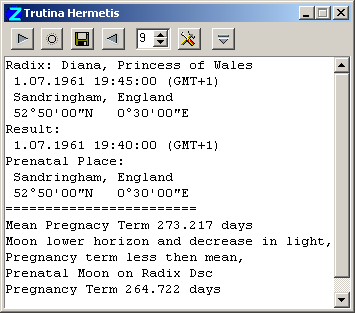Rectification - Trutina Hermetis
Rectification is the deriving of an exact time for a nativity whose time of a birth is unknown. One approach to the problem is the astrological analysis of the pre-natal epoch.
The Pre-Natal Epoch is a very ancient concept. Known as the Trutine of Hermes, or the Trutina Hermetis, and attributed to Hermes Trismegistus, it is cited in the 51st Centiloquy of Ptolemy’s Tetrabiblos, but is now generally considered to have been written in the 10th century by the Arabic astrologer Ja’far Ahmet ibn Yusuf ibn Ibrahim al-daya. Simply put, the Trutine is the relationship between a normal period of gestation (approximately nine months before birth) and the moment of birth, depending on the Moon and the lunar rhythm. This sets up a correlation between the chart for the moment of conception and the chart for the moment of first breath, when the physical body separates from the body of the mother.
The Trutina Hermetis method of rectification is based on the assumption that the positions of the Ascendant and the Moon in the conception chart and the birth chart are interconnected by a rule: the Moon at birth is on the horizon axis of the conception horoscope, and the Moon at conception is located on the horizontal axis of the radix.
In classical form the Trutina Hermetis says:
- When the radix Moon is waxing Moon and above the horizon, the period of pregnancy was less than 273 days, and the Moon in the prenatal epoch chart is conjunct the Ascendant of the radix.
- When the radix Moon is waning Moon and above horizon, the pregnancy was more than 273 days, and the prenatal Moon has the same coordinate as the Descendant of the radix.
- When the radix Moon is under the horizon and waxing, pregnancy was more than 273 days, and prenatal Moon incorporates the radix Ascendant.
- When the radix Moon is under the horizon and waning, pregnancy last less than 273 days, and the prenatal Moon conjoins the Descendant of the radix.
To see how this works in ZET, let's consider Trutina Hermetis using the example of the horoscope of Princess Diana.
Sourced time of birth is 19:45. Let's check it using Trutina Hermetis:
- Erect Diana's natal chart.
- Click the
 "Tools" Toolbar button
or selecte the "Tools" main menu item, then select the "Rectify by 'Trutina Hermetis'" option.
The Trutina Hermetis window is displayed.
"Tools" Toolbar button
or selecte the "Tools" main menu item, then select the "Rectify by 'Trutina Hermetis'" option.
The Trutina Hermetis window is displayed.
- Click the
 Calculate button
at top-left. You should now see:
Calculate button
at top-left. You should now see:

The Trutina gives 19:40. As the 'Condensations' method of rectification gave 19:42, which is between 19:45 and 19:40, the time 19:42 is acceptable.
Trutina Hermetis toolbar
The toolbar buttons are as follows:
- "Calculate" - executes the rectification on the current (core) event data,
- "Hide Prenatal Chart" - deletes the ring of prenatal planets, which is erected on the chart as an additional ring. To replace the chart, repeat the calculation,
- "Save in History" - records the rectified chart in the History log
- "Restore Radix" - replaces the rectified chart (also Event Data, and inner ring planets) with the original source chart,
- "Mean Pregnancy Term [calendar months]" - enables you to set the term for natives born prematurely,
- "Options" - displays a submenu with the options:
- Prenatal City same as Radix one - set this option if applicable. If not then uncheck it, open the "Event Data" window and in a background (not natal) data setup a prenatal city.
- True Horizon - selects the use of the true horizon in the calculation. The resulting difference in rectified birth time may not be insignificant. NOTE: the result is also affected by the setting "Adjust for ellipsoidal Earth" on the General Settings, General tab,
- "Debug" - internal use only.
[Parts adapted from The Mountain Astrologer, Issue #105, Oct/Nov 2002. Download now.]